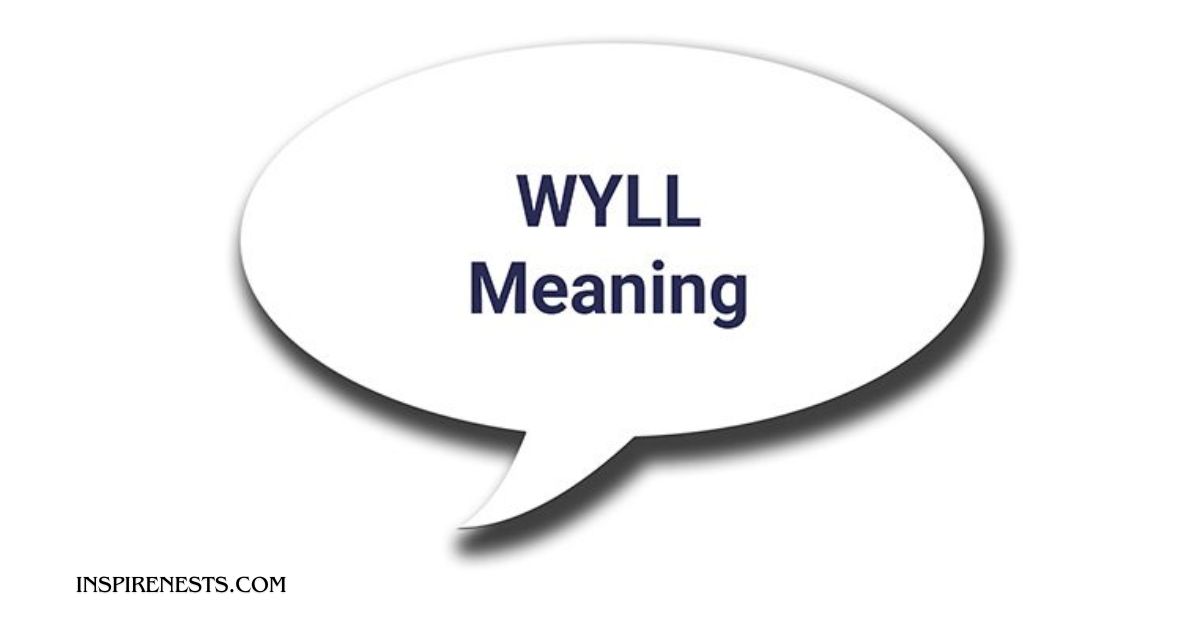The English language contains many words that can confuse people. One such term is “wyll.” Many people wonder about the wyll meaning and how to use it correctly. This guide will help you understand everything about wyll meaning and its proper usage.
Understanding the wyll meaning is important for clear communication. This article will cover the history, modern usage, and alternatives to this unique term. By the end, you will know exactly what “wyll” means and when to use it.
- Read More: 2025 Pookie Meaning
Understanding the Core Wyll Meaning

What does wyll mean exactly? The wyll meaning is simple. “Wyll” is an old way to spell “will.” It is a modal verb that shows future tense actions, desire, or intention.
The basic wyll meaning is the same as “will” in modern English. Both words express plans for the future. They also show willingness to do something.
In historical texts, the wyll meaning was common. Writers used “wyll” instead of “will” hundreds of years ago. Today, most people use “will” in their writing and speech.
The wyll meaning has not changed over time. Only the spelling has changed. This makes it easier to understand when you see “wyll” in old books or documents.
The Historical Context Behind Wyll Meaning
Historical linguistics shows us how words change over time. The wyll meaning comes from Middle English. This was the English language used between 1150 and 1500.
During this time, the wyll meaning was exactly like our modern “will.” Writers used “wyll” to show future tense actions. They also used it to express desire and intention.
Language evolution changed the spelling from “wyll” to “will.” This happened slowly over many years. The wyll meaning stayed the same, but people preferred the shorter spelling.
Old English texts show many examples of wyll meaning in action. These texts help us understand how people used this spelling variant long ago. The wyll meaning appears in religious texts, legal documents, and personal letters from the past.
Contemporary Wyll Meaning in Digital Communication
Modern contextual usage of wyll meaning is rare. Most people today use “will” instead of “wyll.” However, some people still use “wyll” in special situations.
Digital communication sometimes includes the wyll meaning for style. Some writers use “wyll” in creative writing or historical fiction. This helps create an old-fashioned feeling in their work.
The communication tone changes when writers use “wyll” instead of “will.” It can make text sound more formal or historical. However, most readers prefer the modern spelling “will.”
Understanding wyll meaning helps when reading older texts. It also helps when someone uses this spelling variant in modern writing.
Practical Applications of Wyll Meaning
Wyll Meaning in Social Media Interactions
Social media rarely shows wyll meaning usage. Most people use “will” in their posts and comments. The wyll meaning might appear in creative posts or historical content.
When people use wyll meaning on social media, it often creates confusion. Many users do not understand this old spelling variant. This can hurt clear communication.
The best practice is to use “will” instead of “wyll” on social media. This ensures everyone understands your intention and desire to communicate clearly.
Understanding Wyll Meaning in Text Communications
Text messages almost never include wyll meaning. People prefer short, clear words in texts. “Will” is shorter and easier to understand than “wyll.”
If someone uses wyll meaning in a text, they might be trying to sound old-fashioned. They could also be making a mistake. Context helps determine their real intention.
Professional language in texts should avoid wyll meaning. Use “will” to express future tense actions and plans. This keeps your messages clear and professional.
When Wyll Meaning Is Inappropriate
Business communication should not include wyll meaning. Modern professional language uses “will” instead. Using “wyll” can confuse colleagues and clients.
Formality level matters when choosing between “wyll” and “will.” Formal writing requires modern spelling. Informal writing can be creative, but clarity is still important.
Academic writing avoids wyll meaning unless discussing historical topics. Students should use “will” to express future tense and intention in their essays and reports.
Distinguishing Wyll Meaning from Related Expressions
Wyll meaning is different from “we’ll” and other contractions. “We’ll” means “we will” and sounds similar to “wyll.” However, their meanings are different.
The wyll meaning also differs from “well.” These words sound similar but have completely different meanings. “Well” describes good health or proper action. “Wyll” means the same as “will.”
Contextual usage helps determine which word someone means. Reading the whole sentence shows whether they mean wyll meaning or another similar word.
Understanding these differences prevents confusion. It also helps you choose the right word for your own writing and speech.
Best Practices for Using Wyll Meaning Appropriately
When should you use wyll meaning? The answer is almost never in modern writing. “Will” is clearer and more widely understood.
Historical fiction might include wyll meaning for authenticity. Creative writers sometimes use this spelling variant to create an old-fashioned mood. However, most writing should use “will.”
Conversational style affects word choice. Casual conversations work better with simple, clear words. Using wyll meaning can sound pretentious or confusing.
The best practice is to use “will” for all future tense expressions. This ensures clear communication with all audiences.
Professional Alternatives to Wyll Meaning
Instead of using wyll meaning, try these professional language alternatives. “I look forward to” expresses anticipation politely. This phrase works well in business emails and formal letters.
“I plan to” shows clear intention for future actions. This alternative sounds professional and confident. “I intend to” expresses stronger commitment to future plans.
“I’ll be happy to” combines willingness with politeness. This phrase shows eagerness to help others. “I’d like to” expresses desire in a polite way.
“I’m looking forward to” shows positive anticipation. “I’m going to” expresses definite future actions. “I will definitely” emphasizes strong commitment.
“I am eager to” shows enthusiasm for future activities. “I look forward to hearing from you” works perfectly in business correspondence. “It is my intention to” sounds very formal and official.
These alternatives provide better communication tone than using wyll meaning. They also match different formality levels for various situations.
Avoiding Wyll Meaning Misconceptions
Common mistakes happen when people confuse wyll meaning with other words. Some people think “wyll” is a contraction like “we’ll.” This is wrong. “Wyll” is simply an old spelling of “will.”
Another mistake is thinking wyll meaning is more polite than “will.” Both words have the same politeness level. The only difference is the spelling.
Some people believe using wyll meaning makes their writing sound smarter. This is false. Clear, modern language is always better than confusing old spellings.
Understanding these misconceptions helps you communicate better. It also prevents embarrassing mistakes in your writing.
The Evolution of Wyll Meaning in Modern Language
Language evolution continues to change how we communicate. The wyll meaning represents an older stage of English development. Most modern speakers prefer “will” for clarity.
Future tense expressions will likely keep using “will” instead of “wyll.” The trend toward simpler spelling supports this prediction. Modern digital communication values speed and clarity over historical accuracy.
Educational systems teach “will” as the standard modal verb for future tense. This ensures new generations understand proper modern usage. However, knowing wyll meaning helps when reading historical texts.
The wyll meaning will remain important for understanding old literature and documents. Students and researchers need this knowledge for historical studies.
Mastering Wyll Meaning for Effective Communication
Understanding wyll meaning improves your language skills. You now know this term is simply an old spelling of “will.” Both words express future tense, intention, and willingness.
Contextual usage determines when to use historical spellings like “wyll.” Modern communication almost always requires “will” instead. This ensures clear understanding with all audiences.
Remember the professional alternatives mentioned earlier. “I look forward to”, “I plan to”, and “I intend to” offer variety in your expression. These phrases match different formality levels and communication tones.
Good communication requires choosing the right words for your audience. Understanding wyll meaning helps you read historical texts. Using “will” helps you communicate clearly today.
Common Questions About Wyll Meaning
What is the exact wyll meaning in different contexts?
The wyll meaning is always the same as “will.” Context does not change this basic meaning. Both words express future tense actions and intentions.
How do I respond when someone uses wyll meaning in conversation?
Treat it exactly like “will.” The wyll meaning requires the same responses as modern “will.” Do not let the old spelling confuse you.
Is wyll meaning appropriate for professional communication?
Professional language requires clear, modern spelling. Use “will” instead of “wyll” in business writing and formal communication.
What are the cultural implications of wyll meaning usage?
Using wyll meaning might seem pretentious or confusing. Most people prefer simple, clear language. Save historical spellings for creative writing or historical research.
Conclusion
The wyll meaning represents a fascinating element of language evolution, demonstrating how spelling variants transform over centuries while maintaining core functionality. This comprehensive analysis reveals that understanding wyll meaning enhances both historical literacy and modern communication effectiveness.
While “wyll” served as the standard modal verb in historical texts, contemporary professional communication requires the modern spelling “will” to ensure clarity and accessibility.
The professional alternatives presented throughout this guide, including “I look forward to”, “I plan to”, and “I intend to”, provide sophisticated options for expressing future tense and intention across various business contexts. These expressions demonstrate appropriate formality levels while maintaining politeness and professional language standards.

Admin of Inspirenests.Com, dedicated to fostering educational growth and inspiration. Passionate about delivering reliable and insightful resources to empower learners and educators on their journey to success.
